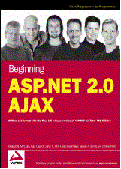Book Excerpt: Introduction to ASP.NET AJAX
Over the years, we developers have seen many changes in terms of how development
occurs. We have gone from terminal-based programming to PC-based programming to
Windows-based programming and to the Web. Now we are on the verge of another
programming revolution— one that will bring about more interactive user
interfaces to web applications. This programming revolution is brought to
developers courtesy of a set of technologies that are generally known as AJAX
(Asynchronous JavaScript And XML). No longer will users see the annoying flash
with the clicking of a button to submit data. No longer will users lose the
context of where they are located and be thrown back up to the top of a page.
With AJAX, developers can build applications that step out of the traditional
postback model of the Web, provide an improved user interface to users, and
allow developers to develop applications that are much friendlier to use.
|

Book Excerpt: Introduction to ASP.NET AJAX
Chapter Contents
|
This excerpt from
Beginning ASP.NET 2.0 AJAX by Wallace B. McClure, Paul Glavich,
Steve C. Orr, Craig Shoemaker, Steven A. Smith, Jim Zimmerman, is printed with
permission from Wrox Publication.
This chapter looks at the following:
-
ASP.NET development and how it led to AJAX
-
What AJAX is and a high-level overview of some of its base technologies
-
The advantages of AJAX
-
What ASP.NET AJAX is
-
Some things that it might not make sense to do with AJAX
Chapter Contents
|
Page
1 | page
2 | page
3 |
page 4 |
page 5 |
page 6 |
page 7 |
page 8
Also Read
This includes caching mechanism in ASP.NET, its advantages and types.
Here you have details about exception handling and ways to handle exception in
ASP.NET. It also includes brief detail of Try/catch block, Error Events
and Custom Error Pages.
Here you have description of globalization, localization and their approaches in
ASP.NET. It also describes resource files and satellite assemblies.
|